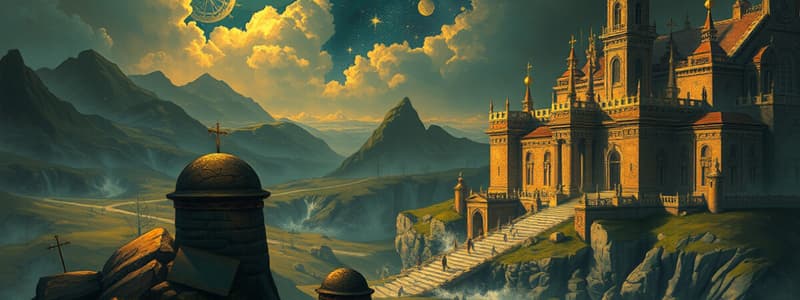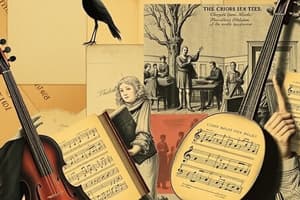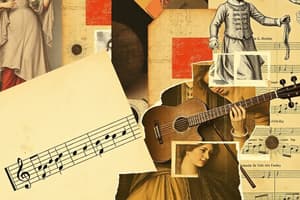Podcast
Questions and Answers
The Baroque period lasted approximately from 1600 to ______.
The Baroque period lasted approximately from 1600 to ______.
1750
Johann Sebastian Bach is known for his compositions like fugues, cantatas, and ______.
Johann Sebastian Bach is known for his compositions like fugues, cantatas, and ______.
concertos
A key form in Renaissance music is the ______, a choral composition with sacred text.
A key form in Renaissance music is the ______, a choral composition with sacred text.
motet
The Medieval period is characterized by monophonic texture, with a single melodic line known as ______.
The Medieval period is characterized by monophonic texture, with a single melodic line known as ______.
George Frideric Handel is famous for his works in opera, oratorios, and orchestral ______.
George Frideric Handel is famous for his works in opera, oratorios, and orchestral ______.
In Renaissance music, increased focus on text expression and clarity led to the development of ______ scales.
In Renaissance music, increased focus on text expression and clarity led to the development of ______ scales.
The lute is a common musical instrument from the ______ period, used in both secular and sacred music.
The lute is a common musical instrument from the ______ period, used in both secular and sacred music.
Gregorian Chant is characterized by its ______ melodies and is named after Pope Gregory I.
Gregorian Chant is characterized by its ______ melodies and is named after Pope Gregory I.
Flashcards are hidden until you start studying
Study Notes
Baroque Compositions
- Time Period: Approximately 1600-1750.
- Characteristics:
- Emphasis on contrast (e.g., loud vs. soft, solo vs. ensemble).
- Use of ornamentation and improvisation.
- Expressive melodies with intricate harmonies.
- Key Composers:
- Johann Sebastian Bach: Known for fugues, cantatas, and concertos.
- George Frideric Handel: Famous for operas, oratorios, and orchestral suites.
- Important Forms:
- Concerto: A piece for a solo instrument with orchestral accompaniment.
- Suite: A collection of dances, often in a specific key.
- Opera: A dramatic work combining music, singing, and sometimes dance.
Renaissance Musical Forms
- Time Period: Approximately 1400-1600.
- Characteristics:
- Greater use of polyphony and harmony.
- Development of modal scales.
- Increased focus on text expression and clarity.
- Key Forms:
- Motet: A choral composition with sacred text, typically polyphonic.
- Mass: A musical setting of the liturgy, composed for choir and sometimes soloists.
- Chanson: A French song, often secular, characterized by poetic text.
- Key Composers:
- Josquin des Prez: Renowned for his use of imitation and expressive melodies.
- Giovanni Pierluigi da Palestrina: Known for his smooth polyphony and clarity in sacred music.
Medieval Chant
- Time Period: Approximately 500-1400.
- Characteristics:
- Monophonic texture, single melodic line without harmony.
- Use of Latin texts, often religious in nature.
- Free-flowing rhythm, following the natural accents of the words.
- Types:
- Gregorian Chant: The most famous form, named after Pope Gregory I, characterized by its modal melodies.
- Ambrosian Chant: A style of chant associated with the Milanese liturgy.
- Notation: Early forms of musical notation (neumes) to indicate pitch but not rhythm.
Instruments Of The Periods
-
Medieval Instruments:
- Lute: A plucked string instrument common in both secular and sacred music.
- Hurdy-gurdy: A string instrument played by turning a crank, producing a drone.
- Recorder: A woodwind instrument favored for its sweet tone.
-
Renaissance Instruments:
- Viola da gamba: A bowable string instrument similar to the modern cello.
- Sackbut: An early form of the trombone, used in both ensembles and solo performances.
- Clavichord and harpsichord: Keyboard instruments that became prominent in chamber music.
-
Baroque Instruments:
- Violin: Became a principal instrument in orchestras and chamber music.
- Organ: Central to church music, often used for improvisation.
- Theorbos and chitarrones: Lute family instruments with a larger body and longer neck for low bass lines.
Baroque Compositions
- Time period spans approximately 1600-1750, characterized by dramatic expression.
- Strong emphasis on contrast such as dynamics (loud vs. soft) and textures (solo vs. ensemble).
- Notable for rich ornamentation and an emphasis on improvisation within compositions.
- Melodies are expressive and often accompanied by intricate harmonies.
- Johann Sebastian Bach is renowned for his fugues, cantatas, and concertos, showcasing his mastery of counterpoint.
- George Frideric Handel is celebrated for his operas, oratorios, and orchestral suites, blending theatrical elements with music.
- Important musical forms include:
- Concerto: Highlights a solo instrument against orchestral accompaniment.
- Suite: A collection of diverse dances, typically composed in a specific key.
- Opera: A comprehensive dramatic work integrating music, singing, and occasionally dance.
Renaissance Musical Forms
- Encompassing the period from approximately 1400-1600, marked by an artistic flourish.
- Increased use of polyphony and harmonic depth elevates the complexity of compositions.
- Development of modal scales provides new tonal frameworks and enhances musical texture.
- Heightened focus on text expression leads to improved clarity in vocal works.
- Key forms include:
- Motet: A polyphonic choral composition usually featuring sacred texts.
- Mass: A musical setting that follows the liturgy, typically sung by choir and soloists.
- Chanson: A distinctly French song, often secular, celebrated for its poetic lyrics.
- Notable composers such as Josquin des Prez, known for his expressive melodies and innovative imitation, and Giovanni Pierluigi da Palestrina, lauded for his clear and smooth polyphony in sacred music.
Medieval Chant
- Spanning the period approximately from 500-1400, primarily associated with early religious music.
- Characterized by monophonic texture, featuring a single melodic line devoid of harmony.
- Latin texts dominate, primarily linked to religious themes and worship practices.
- Rhythm tends to be free-flowing, aligning naturally with the phrasing of words.
- Key types include:
- Gregorian Chant: The most recognized chant form, named after Pope Gregory I, known for modal melodies.
- Ambrosian Chant: An alternative style related to the Milanese liturgy.
- Early music notation used neumes to indicate pitch, lacking a rhythmic component.
Instruments Of The Periods
-
Medieval Instruments include:
- Lute: A versatile plucked string instrument favored in various musical contexts.
- Hurdy-gurdy: A unique string instrument producing sound through crank-operated mechanisms.
- Recorder: A woodwind instrument lauded for its melodious sound and accessibility.
-
Renaissance Instruments consist of:
- Viola da gamba: A string instrument played with a bow, similar to the modern cello.
- Sackbut: An early trombone variant used in numerous musical settings.
- Clavichord and harpsichord: Keyboard instruments gaining prominence in chamber music performances.
-
Baroque Instruments feature:
- Violin: Became central to orchestral music and chamber works during this period.
- Organ: A focal instrument in church music, often utilized for improvisational purposes.
- Theorbo and chitarrone: Lute family instruments designed for bass lines, known for their unique construction.
Studying That Suits You
Use AI to generate personalized quizzes and flashcards to suit your learning preferences.




